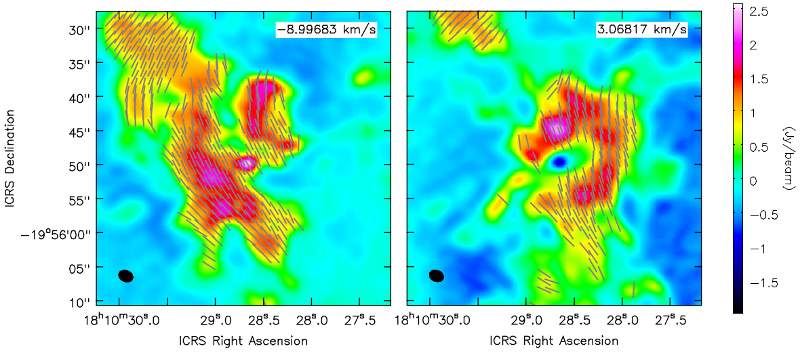| EPoS Contribution |
|
ALMA Mapping of Magnetic Fields: the Molecular Cloud G10.6-0.4
Richard Crutcher U Illinois, Urbana, IL, US | |
| ALMA offers the potential for considerably increasing our understanding of the role of magnetic fields in star formation, but significant instrumental polarization has limited this potential. We will very briefly discuss the non-standard polarization calibration techniques we employed that include using both the polarization and phase calibrator sources for polarization calibration, accounting for circular polarization of the calibrators, and iterative polarization self-calibration. These calibration procedures have led to high-quality polarization maps of the G10.6-0.4 high-mass star formation region. The region consists of a large flattened molecular envelope within which there is a rotating and collapsing molecular core and a cluster of OB stars. Our high-resolution ALMA data enable us to use all of the possible observational techniques for detecting and mapping magnetic fields in molecular clouds: polarized dust emission, Goldreich-Kylafis effect linear polarization of spectral lines (CO and CN), the Zeeman effect (CN), and molecular-line velocity gradients. The detection of the GK effect in CN is the first time in a molecule other than CO in a molecular cloud. The various magnetic field tracers sample different regimes and densities, which enables us to study the 3D structure of the magnetic field and the relative importance of the magnetic field, gravity, rotation, collapse, and turbulence in the dynamics of this high-mass star formation region. | |
 | |
| Caption: Examples of the ALMA maps: two continuum-subtracted channel maps of CO Stokes I (color) and CO linear polarization directions (line segments). Magnetic field directions are perpendicular to the CO linear polarization and hence generally parallel to the minor axis of the CO distribution. At the H II region continuum position at the center the two maps, there is redshifted CO absorption and blueshifted CO emission, directly indicating a cloud collapse of about 6 km/s. | |
| Collaborators: A. Kemball, U Illinois, US K.-Y. Huang, U Illinois, US |
Suggested Session:
Magnetic Fields |

